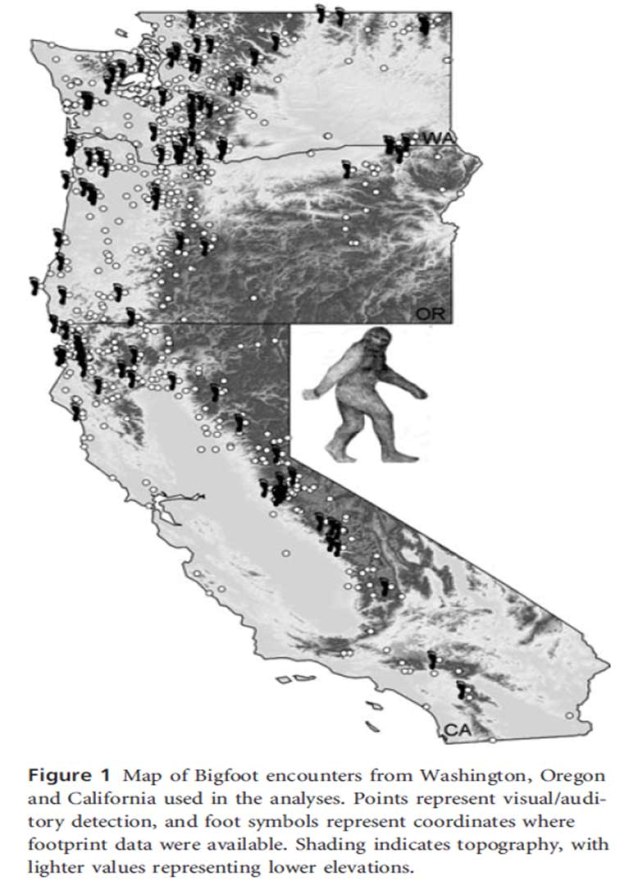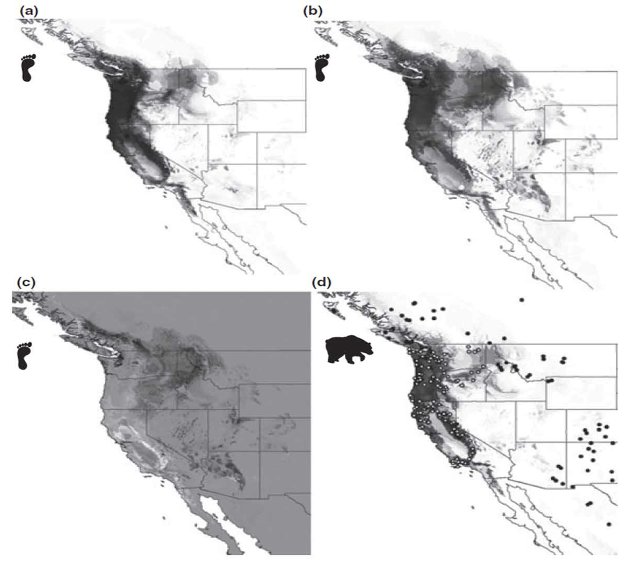In Search of Sasquatch
Posted by: Craig Woolheater on July 31st, 2011
Source: Katatrepsis: Science, skepticism and dragonflies
I have been involved in “climate space modelling” for a few years now. This is an approach that uses observations of a given species to determine the range of environmental variables under which it will occur. Once you know what the limits of its tolerance are, you can predict where the species will occur. For example, let’s say that a damselfly (of course I’m using a hypothetical damselfly) can live at temperature of between 10 and 20 degrees and precipitation has to be between 200mm and 500mm per year. Warmer, wetter, cooler or drier than that and it can’t survive. We can use these limits to predict (i) where the species currently exists but has not been recorded, and (ii) where the species might exist in the future as the climate changes.

These climate models have been used for many different taxa, but recently I came across the first example of such a model being applied to a cryptid. ”Cryptid” is the name given to any postulated species that has not been conclusively documented. Notable examples include the Loch Ness Monster in Scotland and the Chupacabra in Mexico. This study used a database of Sasquatch sightings from the western USA to infer the climatological requirements of this particular cryptid. The point of the study was to demonstrate that researchers can provide apparently meaningful data without any actual biological understanding of the concepts. In this case, we have little or no evidence of the existence of Sasquatch, and yet the researchers published an entire paper documenting its distributions.
Click on image for full size version with caption
However, rather than stopping at this facetious point (it was a paper published on April Fool’s Day), the authors compare the predicted distribution of Sasquatch with that of the black bear, Ursus americanus, using records from same area in which Sasquatch has been sighted. The overlap in distributions is marked and suggests that sightings of Sasquatch, a large, hairy, bipedal animal living in the forest, are mistaken sightings of the black bear, a large, hairy, sometimes bipedal animal living in the same forest… The authors conclude:
Although it is possible that Sasquatch and U. americanus share such remarkably similar bioclimatic requirements, we nonetheless suspect that many Bigfoot sightings are, in fact, of black bears.
I think they’re probably right…
Reference
Lozier, J. D., Aniello, P., Hickerson, M. J. (2009) Predicting the distribution of Sasquatch in western North America: anything goes with ecological niche modelling, Journal of Biogeography, 36: 1365-2699
About Craig Woolheater
Co-founder of Cryptomundo in 2005.
I have appeared in or contributed to the following TV programs, documentaries and films:
OLN's Mysterious Encounters: "Caddo Critter", Southern Fried Bigfoot, Travel Channel's Weird Travels: "Bigfoot", History Channel's MonsterQuest: "Swamp Stalker", The Wild Man of the Navidad, Destination America's Monsters and Mysteries in America: Texas Terror - Lake Worth Monster, Animal Planet's Finding Bigfoot: Return to Boggy Creek and Beast of the Bayou.










Very nice post, Craig. I actually cited this paper in my master’s thesis. If you have access to the academic databases Digital Dissertations or JStor, there are quite a few scientific papers related to Bigfoot. I agree with you about Bigfoot sightings and black bears- any thoughts on sightings in our neck of the woods?
It’s probable that many Sasquatch sightings in the Pac Northwest are black bears, BUT it’s also probable that Sasquatch and U. americanus share the same habitat and only differ in food and methods of obtaining it, thus avoiding each other. Mountain Lions and bear both eat deer, but share the same areas, because that’s where the deer are, and they also have room for wolves and minor carnivores, too.
This mapping is really interesting in setting the likely areas of Sasquatch habitation. Unfortunately, it isn’t detailed enough to be of any use to the field bigfooter. Especially us ‘go sit in the woods’ amateurs. The map is more info in our quest to prove existence, though.
Many, but not ALL.
I wonder how many black bear sightings are bigfoot. I wonder if bigfoot knows it resembles a bear and uses that to its advantage. Most people see what they expect to see as has been proven many times. So if you expect to see a bear that black furry biped is a bear and vice versa.
Ummm.. Craig didn’t write this article. I know the original author of this piece:
In search of Sasquatch
I’ve never heard of someone saying “woah, a BIGFOOT, nope it’s just a bear”…
But I have read several Bigfoot sightings that started out with the person thinking they were seeing a bear and realized; “NO, That’s a…a… BIGFOOT!”
With regards to Ion’s comment, I’d like to point out that Craig referenced the post you linked and is not claiming credit.
Yes, Craig made his source quite clear, ion. Go back and read his post.
I would be completely insulted if I saw a Sasquatch and someone tried to tell me it was, “just a bear.” So much so that said person would walk funny until they removed my boot from their rectum. It’s possible that some folks that don’t belong in that environment, might mistake a bear for Bigfoot, but most anyone who spends a good deal of time in bear country are familiar with bears. They aren’t exactly shy or elusive. Most folks who live in bear country are used to seeing them digging through their garbage cans.
I would be much more tempted to go the other way and say many sightings of black bears might be sightings of Bigfoot, that is assuming there is such a creature. The filters in our adult brains work much like the compression algorithms in a DIVX program. Much of what you “see” is not actually what you see, at least when it comes to familiar objects and environments. If you take a brief glance around your living room, you think that you see the photo of you and your mom at the park, you think you see your car keys hanging on the hook by the door, but you see what you expect to see. “I know my keys were there. I just saw them!” Sound familiar? If you had to “look” at everything we’d be bombarded by the imagery around us and all of our brain power would go to just “seeing” the world around us. So our brains use stored imagery to fill in the little details in our periphery based on what we “should be seeing” not on what we are actually seeing. The black bear hypothesis is actually ass-backwards from reality. The chances of mistaking a bear for Bigfoot are actually quite remote. Something as unusual or unexpected as Bigfoot should stick out and catch our attention, not the other way around. Again, assuming that Bigfoot is real, you would be far more likely to mistake Bigfoot for a bear, than a bear for Bigfoot. Most of us don’t expect to see Bigfoot!
Hello everyone,
As anyone who’s spent much time viewing Google Earth already knows the terrain images in many parts of the Americas has been updated and show details at a significantly higher resolution.
I would predict that it is only a matter of time before we find images of our furry friend; perhaps even a family group. I spend an hour or so per week (on average) viewing likely areas which depict this higher resolution. I have found a couple of possible targets which I will keep to myself for now since they their identities are ambiguous at best. Hopefully I will stumble upon something more identifiable or less prone to vague interpretation eventually. For those who have and use Google Earth—I encourage you to keep your eyes open.